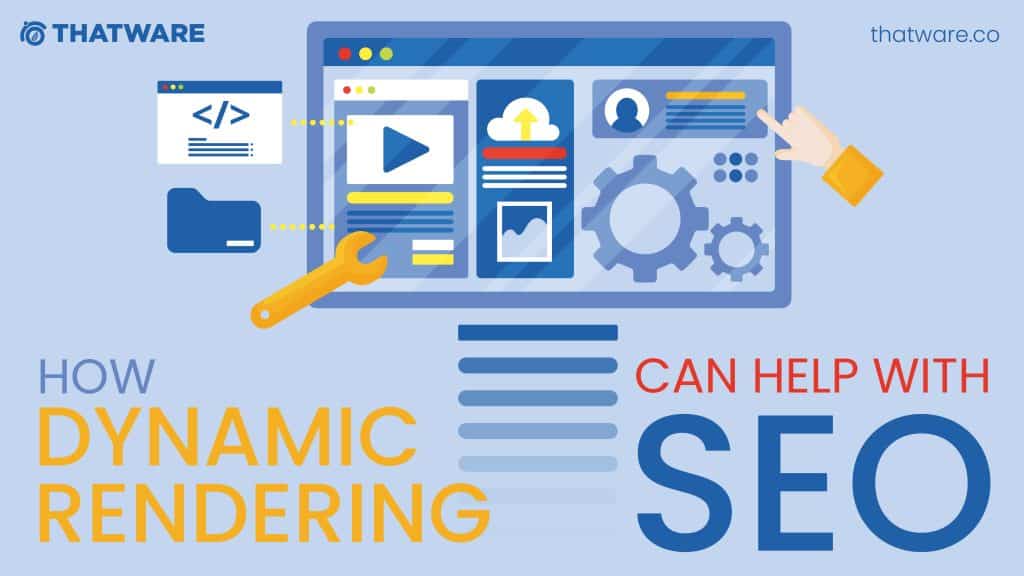SUPERCHARGE YOUR Online VISIBILITY! CONTACT US AND LET’S ACHIEVE EXCELLENCE TOGETHER!
Within the realm of digital marketing, SEO is one of the more technical disciplines. It’s similar to the well-known circus routine in which a juggler spins three plates on poles. It’s like walking on a tightrope when it comes to technical SEO. JavaScript SEO is like setting fire to the tightrope, the dishes, and yourself.
It’s a difficult balancing act to master. Your website must not only be designed in such a manner that search engines can easily digest it, but it must also perform better and load quicker than the competitors.

On the other hand, technical SEO has the advantage of being one of the ranking elements over which you have direct influence. How can you make your JavaScript website easy to read and comprehend for Google while providing a nice online experience for your visitors?
SERVER-SIDE RENDERING (SSR):
Basically, all of your page’s resources are housed on the server. Then, when the page is requested, the HTML is delivered to the browser and rendered, JS and CSS downloaded, and the final render appears to the user/bot.
CLIENT-SIDE RENDERING (CSR):
This relies on JS executed on the client-side (browser) via a JavaScript framework. Essentially the client will first request the source code which will have very little indexable HTML in it, then a second request will be made for the .js file containing all of the HTML in JavaScript as strings.
The solution is dynamic rendering.
Dynamic rendering is a technological SEO strategy that allows you to build both a bot-friendly and a human-friendly version of your website, improving the quantity of material crawled, indexed, and ranked by search engines.
When Google Visits Your Website, What Happens?
Google indexes and catalogues every web page on the Internet using an automated software known as a bot.
Therefore, the declared goal of Google is to offer the best possible result for a given query. To do so, it tries to figure out what material is on a specific web page and how important it is compared to other websites on the same topic.
The three primary programming languages used in modern web development are HTML, CSS, and JavaScript.
Google crawls and indexes HTML in two stages. Googlebot crawls a page’s HTML first. It scans a website’s content and outbound links and extracts keywords that help it figure out what the page is about. Googlebot then indexes the page.
Google and other search engines prefer the content displayed in static HTML.
This technique is more difficult than using JavaScript. There are three phases to rendering JavaScript:
- Crawl
- Render
- Index
For Google to completely comprehend the material in JavaScript, it must analyze it many times. Rendering is the term for this procedure. When Google detects JavaScript on a web page, it queues it and returns to it when it has the resources to render it.
What’s Wrong With JavaScript SEO?
HTML is a web development standard. Search engines easily render HTML-based information. Javascript, on the other hand, is more difficult for search engines to understand. It necessitates a lot of resources.
This implies that JavaScript-based websites eat up your crawl budget. According to Google, their web crawler can handle JavaScript. This, however, has yet to be confirmed. Google will have to use more resources to crawl, index, and render your JavaScript sites. Bing and DuckDuckGo, for example, are unable to parse JavaScript in any way.
Many portions of your page will likely not be indexed since search engines must spend more resources to display your JavaScript pages. For example, Google and other search engines may ignore metadata and canonical elements, crucial for SEO.
Javascript, on the other hand, delivers a pleasant user experience. It’s how you can create dazzling websites that make your users say, “Wow, that was great!”
What is the best way to create a contemporary online experience without compromising SEO?
The majority of programmers use server-side rendering to do this.
Dynamic rendering is the answer.
This is a problem that Google is aware of. That’s why, in 2018, Google introduced dynamic rendering as a remedy for indexation issues caused by the rise of javascript content on the web and also offered Google dynamic rendering documentation and best practice recommendations.
What is Dynamic Rendering And How Does It Work?
When you utilize dynamic rendering, you generate two versions of your site delivered dynamically based on the user-agent that calls it.
To improve the user experience, users are provided with a user-friendly website version using CSS and javascript code.
A bot-friendly, prerendered, static-HTML version of the website is supplied to Google crawlers so that they may swiftly crawl and index each page.
Advantages of Dynamic Rendering
So, how do dynamic rendering help SEO rankings and your business in general?
It allows Google to crawl your website faster and make the most of your crawl budget.
Google allows each website a specific amount of time and resources. As previously said, if your website is difficult to display and crawl, the crawl rate will likely be lower, search engine crawlers will not index all of your pages, and your material will not appear in Google search results.
It also implies that search engine bots may crawl and index more information without affecting the quality of the user experience.
Search engine bots can crawl and index your page considerably more rapidly and efficiently with dynamic rendering. Because search engine bots can better use their crawl budget, they can index more URLs and material on each page, resolving indexation difficulties.
You’ll get better results from your content efforts.
The more information indexed in Google, the more your content marketing efforts and investments in your organic search channel will pay off.
A larger number of organic ranking keywords and an increase in organic impressions, clicks, and conversions are linked to dynamic rendering.
Remember that even if you hire the greatest writers and create the best content, no one will find it in Google search if Google can’t crawl it.
Which Sites Are Preferable For Dynamic Rendering
To help you decide if dynamic rendering is the appropriate option for your website, here is a list of the sorts of websites that gain the most from it.
- Websites that rely on modern javascript functionality
- Websites that rely on social media sharing and chat applications that require access to page content
Dynamic rendering is recommended for:
- Large sites with rapidly changing content that requires quick indexing
- Websites that rely on social media sharing and chat applications that require access to page content
What Is the Best Way to Implement Dynamic Rendering?
The method of implementing dynamic rendering is broken down into three steps.
To convert your dynamic content into static HTML, you must install a dynamic renderer (such as Prerender).
Second, you decide which user agents should receive static content. This often includes search engine crawlers such as Googlebot and Bingbot. You may also want to include others, such as LinkedInbot.
Consider using a cache to store material if your prerendering service causes your server to slow down or your HTTP requests to rise. As a result, determine if your user agents need desktop or mobile content next. Similarly, to provide them with the best option, you can employ dynamic serving.
Last but not least, set up your servers to offer static HTML.
Confirming Your Settings
You must now ensure that dynamic rendering is functioning properly. Hence, here are some ideas to look into:
- Test for Mobile-Friendliness: This is a feature of the Google Search Console toolset. In September of 2020, Google began the move to mobile-first indexing for all domains. To put it another way, Google prioritizes the mobile version of your website above the desktop one. As a result, your website must be mobile-first optimized.
- URL Inspection Tool: You should use a URL inspection tool to ensure that your website is correctly scanned and indexed. This is exactly what the URL Inspection Tool will accomplish.
- Google’s Fetch: This is the metric you’ll use to assess the efficiency of your dynamic renderer. Therefore, it helps you to double-check those specific URLs are submitted for indexing correctly.
- Structured Data Testing Tool: If your website uses schema markup, you’ll want to utilise this tool. As a result, it ensures that your dynamic renderer does not obstruct schema markup.
When Should Dynamic Rendering Be Used?
The use of dynamic rendering to solve your JavaScript SEO issues is a great concept. One of the most significant advantages of dynamic rendering is that it removes any crawl budget concerns while being cost-effective. As a result, it is also simple to execute and does not need significant technological skills.
When should dynamic rendering be used?
If you have a huge website with information that changes regularly, dynamic rendering is an excellent option (e.g. an e-commerce store with revolving inventory). If this is the case, your website will require regular and rapid indexing. Dynamic rendering ensures that all of your sites are correctly indexed and presented in the search results. As a result, websites that rely on social media sharing, such as those with embeddable social media walls or widgets, will also benefit from it.
Is Dynamic Rendering Effective at Cloaking?
Cloaking is the technique of delivering search engine bots and human material that is significantly different. As a result, this is regarded as a black hat SEO strategy. Even though the benefits of cloaking are appealing in the short term, the dangers are not worth it.
Dynamic rendering is not cloaking as long as the end content is the same for crawlers and humans. However, it’s only cloaking if the content served to each is different.
When Should Dynamic Rendering Be Used?
Dynamic rendering is a practical solution to address JavaScript SEO challenges, offering multiple benefits for website owners who want to ensure optimal indexing and performance on search engines. By bridging the gap between complex JavaScript-based websites and search engine crawlers, dynamic rendering eliminates crawl budget concerns, reduces costs, and simplifies execution. Additionally, implementing dynamic rendering does not require extensive technical expertise, making it accessible for businesses of varying sizes and capabilities.
Understanding Dynamic Rendering
Dynamic rendering involves serving a static HTML version of your webpage to search engine bots while presenting the fully dynamic, JavaScript-rendered version to human users. Search engine crawlers, such as Googlebot, often encounter challenges rendering JavaScript-heavy content due to resource constraints or time limits. By pre-rendering pages and serving them as static HTML to crawlers, you ensure all critical content is indexed correctly, preserving both the user experience and SEO performance.
This approach is especially relevant as more websites adopt JavaScript frameworks like React, Angular, or Vue.js to deliver dynamic and interactive experiences. While these frameworks enhance user engagement, they can inadvertently hinder SEO efforts if search engines cannot render the content properly. Dynamic rendering solves this problem by offering an efficient, scalable solution.
Ideal Scenarios for Dynamic Rendering
Dynamic rendering is not a one-size-fits-all solution, but it is invaluable in specific scenarios. Here are some instances where this technique proves most beneficial:
1. Large Websites with Regularly Changing Content
Websites with substantial content updates, such as e-commerce stores with frequently changing inventory, news platforms, or job portals, can significantly benefit from dynamic rendering. These types of sites often require fast and regular indexing to remain relevant in search engine results.
For instance, an e-commerce store with thousands of products and daily updates needs efficient indexing to reflect new items and remove outdated listings. Dynamic rendering ensures that the static HTML version of the site is ready for crawlers, allowing them to index content swiftly without straining their crawl budgets.
2. Social Media-Heavy Websites
Websites relying on social media integrations, such as embeddable social media walls, widgets, or user-generated content, also benefit from dynamic rendering. These integrations often involve JavaScript-heavy components that crawlers may struggle to render. By pre-rendering and serving simplified HTML versions to bots, these websites ensure their dynamic content is indexed accurately while maintaining user engagement.
3. Budget-Conscious SEO Solutions
Dynamic rendering is a cost-effective option compared to alternatives like server-side rendering (SSR). While SSR provides similar SEO benefits, it can be resource-intensive and require significant development expertise. In contrast, dynamic rendering requires fewer resources and offers a simpler implementation, making it an attractive choice for businesses with limited budgets or technical resources.
Addressing Cloaking Concerns in Dynamic Rendering
A common question about dynamic rendering is whether it constitutes cloaking—a black hat SEO practice. Cloaking involves serving vastly different content to search engine bots compared to human users, with the intent of manipulating search engine rankings. This is strictly against Google’s Webmaster Guidelines and can lead to severe penalties, including de-indexing.
Why Dynamic Rendering Is Not Cloaking
Dynamic rendering does not qualify as cloaking as long as the content presented to search engine bots and human users remains consistent. The key distinction lies in intent and execution. When implementing dynamic rendering, the static HTML version served to crawlers mirrors the content and structure visible to human users. This transparency ensures compliance with search engine guidelines while delivering a seamless experience for both audiences.
When Dynamic Rendering Becomes Cloaking
Dynamic rendering crosses into cloaking territory if the content served to crawlers significantly differs from what is shown to human visitors. For example, serving keyword-stuffed pages to search engines while displaying unrelated or incomplete content to users would be considered cloaking. Such practices are not only unethical but also pose serious risks to your website’s credibility and search engine rankings.
Considerations Before Using Dynamic Rendering
While dynamic rendering offers numerous benefits of cloaking, it is not suitable for every website. Before adopting this approach, consider the following:
- Nature of Content: If your website primarily contains static content, dynamic rendering may not be necessary. Traditional SEO techniques might suffice in such cases.
- Resources and Expertise: Although dynamic rendering is relatively simple, some technical understanding is required to implement and monitor the process effectively.
- Long-Term Strategy: Dynamic rendering may be a temporary solution for websites transitioning to more SEO-friendly frameworks. Evaluate whether server-side rendering or other modern approaches might better align with your long-term goals.
Conclusion
Not everyone is a fan of dynamic rendering. However, executing the procedure when your website requires it might make a significant impact. Similarly, an immediate flat HTML rendering intended for crawl bots can alleviate crawl budget concerns while greatly enhancing user experience. This is especially for JavaScript-heavy websites that publish a lot of material.
Google has detailed a few key steps in its help material for this approach. It’s a very easy answer to an issue that may otherwise upend your SEO and user experience efforts. For instance, when compared to a comprehensive server-side rendering solution for the same procedure.
Of course, you may not feel confident in your ability to carry out the procedure independently. You could have concerns about everything from the crawl budget to the implementation procedure. In Addition, we can assist you and can analyze your site as part of our SEO Professional Services to see if dynamic rendering is necessary and ensure its success as part of your SEO and UX initiatives. Get in contact with our experts at ThatWare right now and get started.

Thatware | Founder & CEO
Tuhin is recognized across the globe for his vision to revolutionize digital transformation industry with the help of cutting-edge technology. He won bronze for India at the Stevie Awards USA as well as winning the India Business Awards, India Technology Award, Top 100 influential tech leaders from Analytics Insights, Clutch Global Front runner in digital marketing, founder of the fastest growing company in Asia by The CEO Magazine and is a TEDx speaker.


